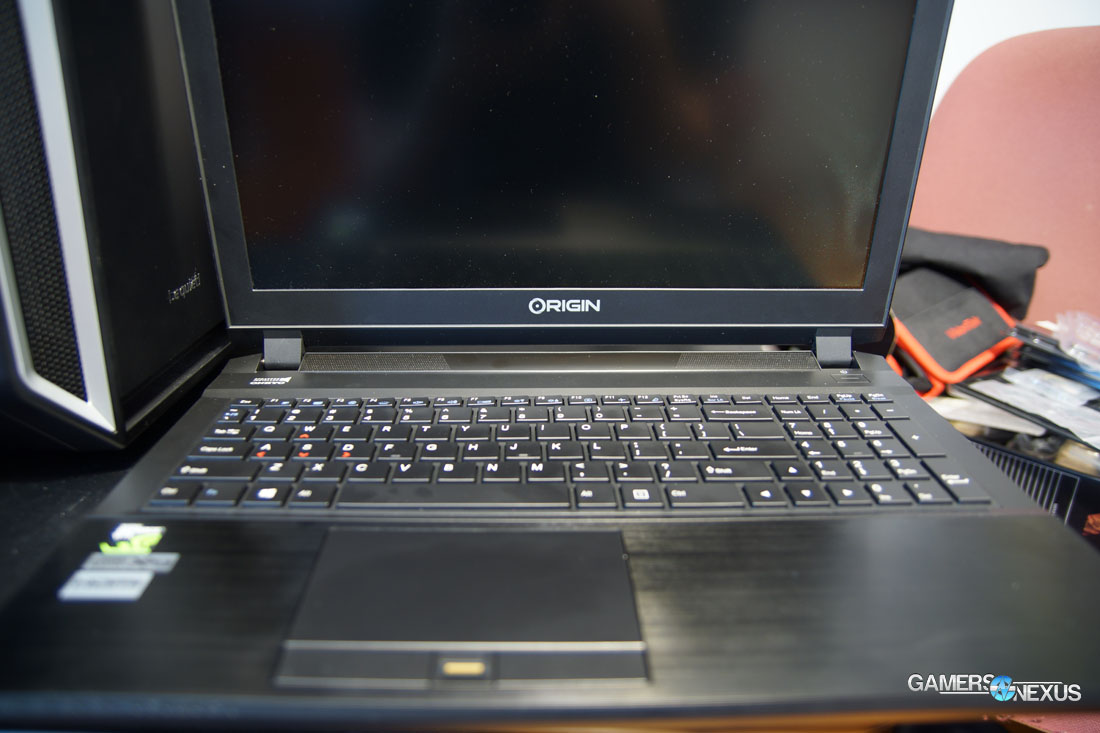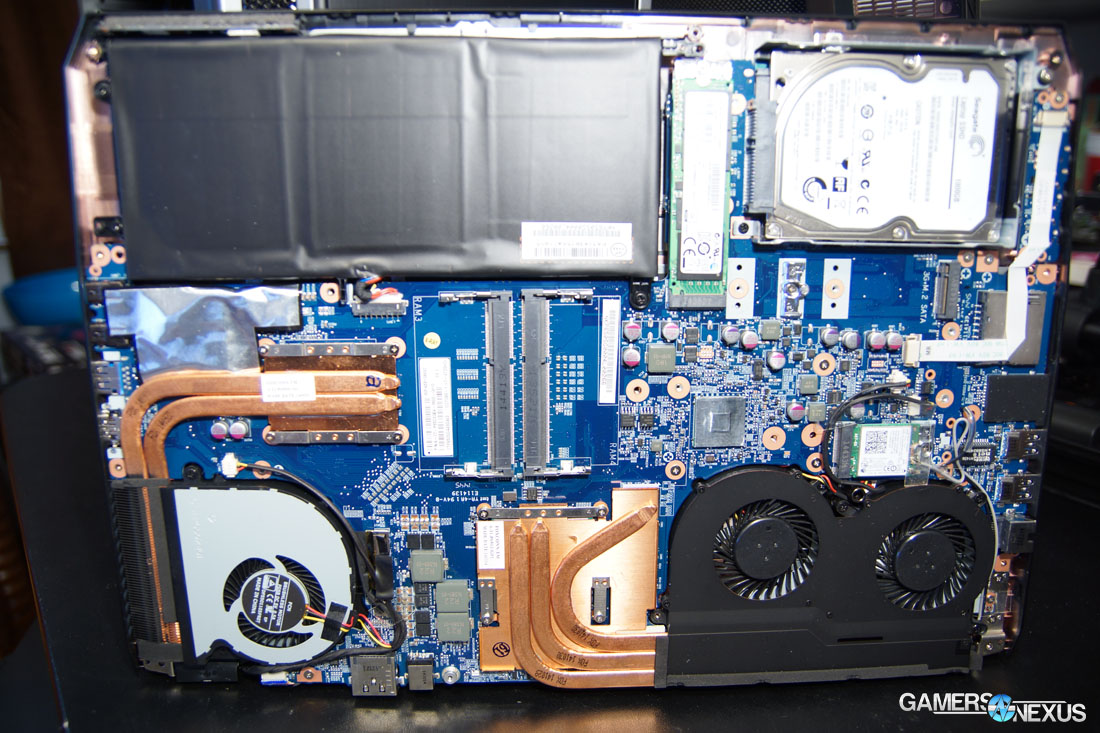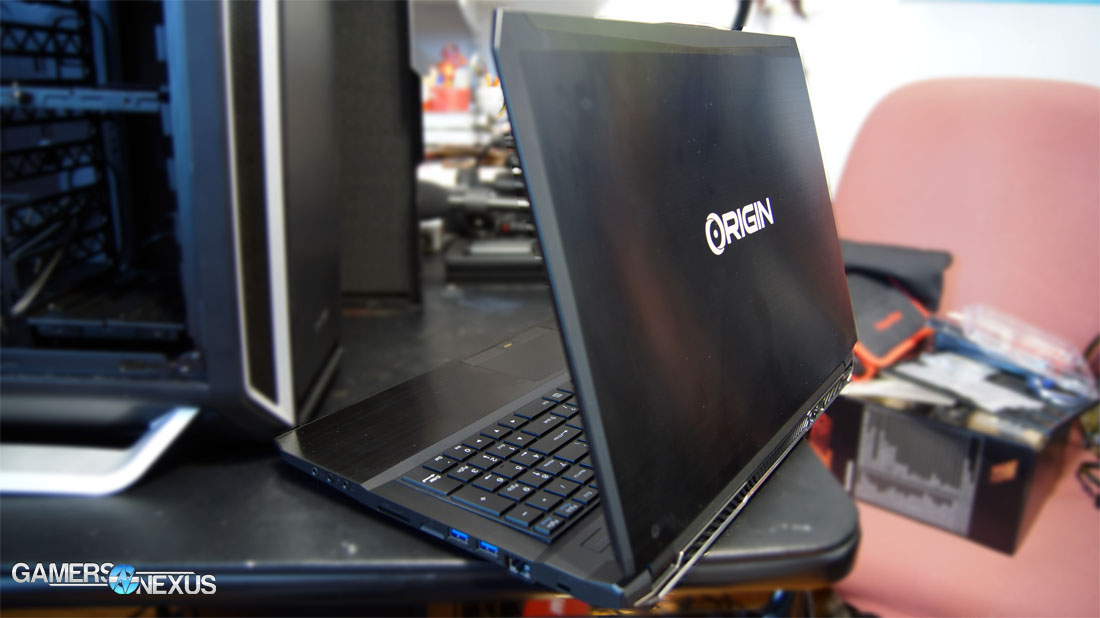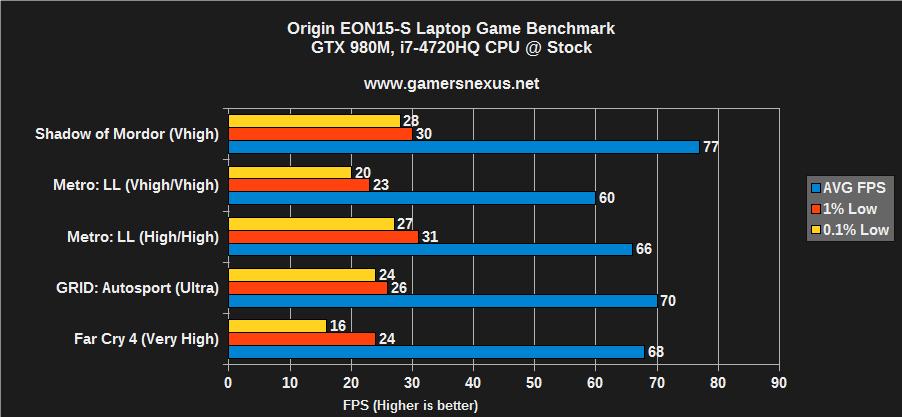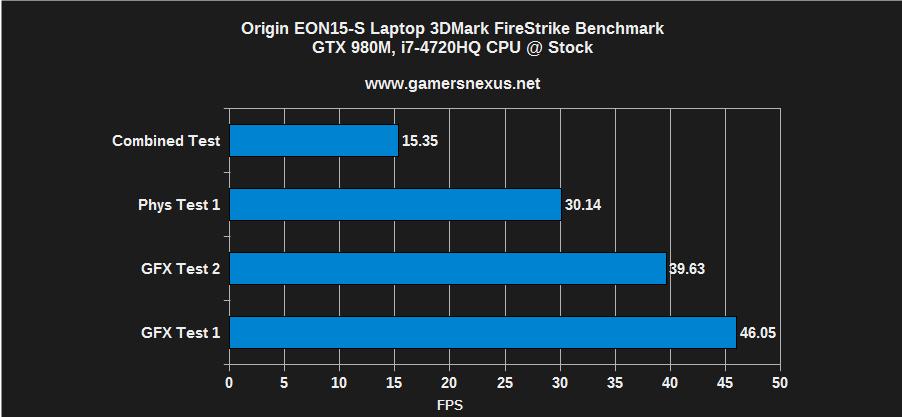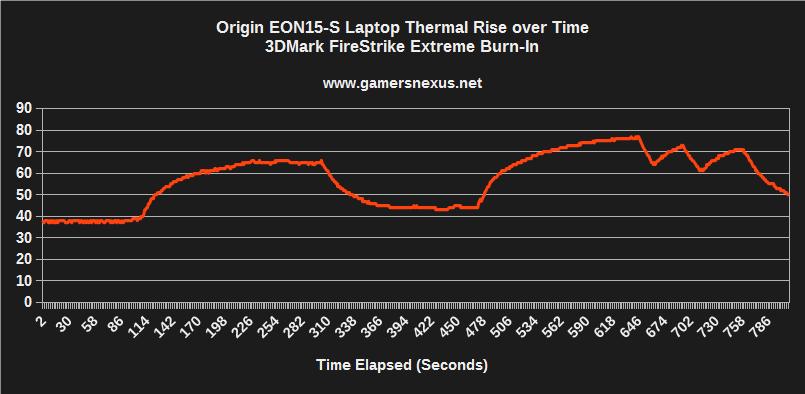Origin EON15-S Thin Gaming Laptop Review - 980M & i7-4720HQ Benchmarks
Posted on May 5, 2015
The performance disparity between same-architecture desktop and mobile GPUs has historically been comparable to multi-generational gaps in desktop components. Recent advancements by GPU manufacturers have closed the mobile performance gap to about 10% of the desktop counterparts, an impressive feat that results in low-TDP, highly performant laptops with longer battery life.
Battery life has long been a joke for gaming laptops. To yield gaming prowess of any measure, notebooks are normally affectionately named “desktop replacements” and never disconnected from the wall. As modern architectures have improved process nodes and reduced power requirements, it's finally become possible for gaming laptops to operate for a moderate amount of time on battery. Battery life is dictated by a few key points: Active power consumption of the components, thermal levels of the system and battery, and power efficiency at other locations in the stack (S0iX on CPUs, DevSleep with SSDs, for instance).
We recently reviewed CyberPower's Fangbook III – an MSI GT70 reskin – remarking that its power output afforded tremendous speed even in professional video editing applications, but that its size necessitated the purchase of a plus-size backpack. This single fact relegated the 18-plus inch Fangbook to desktops, serving as a viable convention-going workhorse, but allowing zero mobility. Having seen that a modern i7 and GTX 980M mobile pairing could outperform many desktops, we decided to venture into portable, high-performance notebooks.
Origin PC's EON15-S shipped to us with a GTX 980M (4GB), an i7-4720HQ 2.6GHz CPU, 16GB DDR3-1600 Corsair memory, 240GB M.2 SSD + 1TB SSHD, and a 1920x1080 display. The unit, as with all Origin notebooks, is built-to-order (BTO) for the user; this allows component modifications as budget demands.
In this review of the Origin EON15-S gaming laptop, we'll look at portability, battery life when gaming, FPS benchmarks, thermals and thermal design, and overall value.
Origin EON15-S Gaming Laptop Specs
| OEM Model | Origin EON15-S 15.6" Gaming Notebook |
| Source Model | Clevo P650SG (Sager NP8652-S) |
| Display | 15.6" FHD Widescreen LED-backlit TN panel 1920x1080 max resolution |
| CPU | Intel Core i7-4720HQ Quad-Core 2.6GHz (3.6GHz TurboBoost) |
| GPU 1 | NVIDIA GeForce GTX 980M 4GB GM204 28nm GPU 1038MHz Core Clock (GPU) 1253MHz Memory Clock (GPU) |
| GPU 2 | Intel HD 4600 (GT2) 22nm IGP 400MHz core clock 800MHz memory clock 20 EUs |
| Motherboard | Notebook P65_P67SG |
| Memory | 2x8GB (16GB) DDR3-1600 Corsair memory (798MHz 9-9-9-24-1T) |
| Storage | 1xSamsung M.2 256GB SSD (MZHPU256HCGL-00004) 1xSeagate 1TB SSHD (7200RPM) (ST1000LM014-1EJ164) |
| Operating System | Windows 8.1 64-bit Free upgrade to Windows 10 |
| Price | ~$2017 |
Note: The above specifications are for the review unit we received. Origin's website allows customization of the EON15-S, including cheaper options that start around $1840.
Origin uses Intel's new Haswell i7-4720HQ CPU, operating at a clock frequency of 2.6GHz and hosting four physical cores and eight logical threads (hyperthreaded). The 4720HQ shipped in 1Q15 as a follow-up to the mobile lineup for Haswell. The 4720HQ still uses a 22nm process node and employs the same Haswell architecture that we've grown accustomed to, allocating a portion of the die space to the HD 4600 IGP. Coupled with the GTX 980M, this die segmentation allows for greater efficiency when performing tasks that don't explicitly demand high-horsepower processing; disabling the discreet graphics chip and deferring to the HD 4600 for graphics processing will extend battery life and reduce heat and noise.
The HD 4600 hosts 20x400MHz EUs (1.2GHz Turbo Boost), awarding a sizable 30% to 50% performance boost against the HD 4000.
A 47W TDP of the i7-4720HQ and ~125W TDP of the GTX 980M ensure profoundly low power consumption compared to the performance output.
What Value Does a System Integrator Offer?
The EON15-S is Origin's attempt at a highly mobile, high-performance gaming laptop with production capabilities. The $1837 starting price-point is frightening as a consumer, but not unfair given the component selection and portability. And it is portable – the EON15-S measures in at 15.1 x 10.6 x 1.1” (just shy of Ultrabook territory) with a weight of 5.5lbs.
After using Origin's configurator, it appears that our review model – which includes a Samsung M.2 SSD – stands closer to ~$2017 before shipping.
Some quick research reveals that the EON15-S is the OEM version of the Clevo P650SG (Sager NP8652-S), a $1667 notebook with very similar specs. For the unfamiliar, most laptop manufacturers will source a chassis and core components from a supplier – like MSI or Clevo – and rebrand the unit. Manufacturers will further differentiate themselves as OEMs by making some modifications to the components (drive configuration changes, addition of an OS) and by offering more comprehensive support plans.
To this end, the ~$350 price gap is quickly closed: The stock Clevo notebook ships with no OS (about $100 in cost added) and the EON15-S offers a 2x larger M.2 SSD.
Further assisting in mentally justifying a purchase from Origin, the OEM is presently (and these change with the day) offering a free $50 Amazon gift card, Witcher 3 game, and Intel Software Game Bundle in addition to the laptop. Not a bad value-add. In the least, the Amazon card is usable.
Origin's default (included) warranty policy includes lifetime labor coverage, 24/7 technical support, and a 1-year parts plan. I question the value of the next step up, which offers a free shipping warranty in exchange for $70 more on initial purchase.
Value of the core components appears good overall. We looked through other buying options and found “screen calibration” for $30 more – not something I'd sink money into – and an Avermedia C875 capture card for $187 extra, which can be had directly via retail channels for $155. That Amazon gift card could even be put toward the purchase. An added $32 cost for the same product doesn't seem like a great buy, as a capture card is an external unit that requires equal setup regardless of seller.
Not to be dismissive of the support and customization support offered by Origin – most manufacturers do something like that – but it's the small things that caught my attention far quicker: The laptop shipped with a kit of thermal pads, presumably so they can be given to a technician when inevitably required, a 14GB Kingston USB3.0 key with OS recovery tools, a shirt, and a (superfluously “gamer-y”) poster.
Origin EON15-S Chassis, Thermal Design, & Maintenance
Thermal design of the EON15-S is a little toned-down from the behemoth that was CyberPower's Fangbook, but allows for a smaller profile. Removing the underside exposes three fans and several copper heatpipes routing through copper coldplates for the CPU and GPU.
The ease of accessibility – as with the Fangbook – ensures relatively effortless component swapping by the end-user, should they decide to replace a drive or add more memory (two slots on the underside). Direct access to the storage components is granted, as is access to the wireless card.
Adiabatic walls are a big concern with laptops. Notebooks have a tendency to trap heat in a fashion which is damaging to internal components as the system ages and thermal compound and other TIM ages. We'll test cooling abilities below.
Origin EON15-S Display & Audio
The 1920x1080 display looks fine, but leaves a bit to be desired. This seems to be true with most modern laptop screens. We found the display to offer poor viewing angles (almost unavoidable with a TN panel, granted) and duller colors. As long as you're seated straight in front of it and not attempting to share with people at poorer viewing angles, output is acceptable.
Short of performing dB testing, the EON15-S' audio levels are fittingly loud when maxed-out, so you won't need to worry about an inaudible laptop. This is a problem we've encountered with past laptops (and my current personal unit) and proves to be legitimately detrimental to usability. The EON15-S doesn't use the same subwoofer / driver configuration as the Fangbook (GT72/GT70), but still employs powerful drivers aimed at a slight angle toward the user's assumed ear position. This ensures that audio is near ideal noise levels when relying upon the built-in speakers.
Test Methodology
Our laptop test methodology parallels what we employ in GPU reviews. We tested using Metro: Last Light's benchmark on high & very high settings, Grid: Autosport on ultra (4xMSAA), Shadow of Mordor on very high, and Far Cry 4 on very high. Synthetic testing was performed using 3DMark. Thermal data was logged during the 3DMark Firestrike Extreme test, stressing the GPU at 100% load for 30 minutes.
For testing battery life, we set GRID: Autosport's benchmark to run on loop and disconnected the AC adapter. The time at which the system entered sleep (from low battery) was logged, then we used simple math to extract the battery life.
All FPS tests were performed three times for parity. FRAPS was used to log FPS data in 30-second increments, then that data was dissected with a spreadsheet. These tests were conducted with AC connected and disconnected.
As a reminder, our benchmark shows these items:
- Average FPS: The time-averaged frames per second of gameplay.
- 1% Low FPS: The FPS displayed 1% of the time. This is a better indicator than "minimum" because it is not an outlier and is more likely to jar the user.
- 0.1% Low FPS: Same as above, except 0.1% of the time.
EON15-S & GTX 980M Benchmark (Gaming FPS)
Despite high average FPS values, we see staggeringly large drops in performance through the 99th percentile and 99.9 percentile metrics. This issue seems to show itself only in recent mobile computing units we've tested and is generally non-existent in desktop dGPUs.
The drops are bad enough that they're highly visible when gaming; with GRID, a highly-optimized game, we encountered dragged-out sequences of severe lag and frame delay with a frequency of about once per minute. Not terribly frequent – 1% of the time – but annoying. We found that dropping settings nominally assisted in resolving the frame disparity, though average FPS should suggest that higher settings are permissible.
We wanted to test GTA V but, due to issues on Rockstar's end, the game is presently not playing well with mobile GPUs from any manufacturer. This is not something within Origin's or nVidia's control.
Average FPS performance is very high for all tested games. Metro: Last Light yields the poorest performance when configured with very high settings and very high tessellation, two items that heavily impact the GPU. A 60FPS minimum for such high settings is not anything to scoff at.
EON15-S & GTX 980M 3DMark Performance
Using the FireStrike (normal) test, we found the below results:
This is meant more as comparative data than anything. 3DMark is not best-deployed in a vacuum, as we've done here, but until we have more same-market laptops to bench, we're testing them standalone. The output score was 8152.
EON15-S & GTX 980M Battery Life When Gaming
As discussed in our previous 980M article, battery operation enforces a hard FPS limit on nVidia hardware, allowing greater battery life at the cost of performance. The GTX 980M will throttle all games down to a 30FPS baseline when no power cable is connected, making for relatively playable framerates in some types of games, but poor playability in more competitive FPS games. You'll need a power-drop for that.
In testing the battery, we ran GRID: Autosport using Ultra settings at 1080p (no charger connected) and then used Windows monitoring utilities to log system uptime and its battery-saving shutdown. Total gaming time on the laptop looks to be about 71 minutes (1 hour, 11 minutes). Compared to the much larger Fangbook, which cools more efficiently (less abusive on the battery cells) and has a bulkier battery, the EON is only 13 minutes shorter in gaming lifespan.
EON15-S Laptop Thermal Analysis & Temperatures
Laptops are notorious for high thermals and serious hits to functionality as they age. I can't count the number of laptops for which I've performed surgery, often involving thermal pads, new paste, and the discovery of burn marks on neighboring plastic.
For this reason, we put test laptops under severe gaming simulation load for thirty minutes, then log the data over time. FireStrike Extreme is used for this task. Logging is performed using MSI Afterburner. Once the test concludes, we import the Afterburner log into a spreadsheet and chart thermals against time. This helps visualize important data, like the time requirement to cool down the components as load fluctuates.
The EON gets a little warm with the CPU, which hit 59C (delta T over ambient) several times throughout testing. This begins to get concerning – any warmer and it'd be time to ease-up on load. If ambient temperature is 21C, that puts the CPU at roughly 80C.
Average GPU temperature hovers at 42.93C (delta T over ambient).
Note that the 3DMark results do not subtract ambient, but this can be done manually by reducing temperature numbers by 21C.
Conclusion: With Origin, You're Paying for the Service
(Above: CyberPower Fangbook III on top, Origin EON on bottom. Large size difference).
The computer hardware industry is heavily saturated with OEMs – manufacturers who buy parts and tweak, then rebrand them – and system integrators, but there's normally some differentiation in the form of services offered. Alongside the above items, like the support plan, Origin also offers custom paint and laser etchings for interested users. Further appreciation for the tech savvy audience is shown by way of bloatware removal; that is, Origin heavily emphasizes that its systems ship without any unnecessary software, instead sticking to the absolute essentials for operation of the unit.
Origin does include a small, useful tools folder with the image deployment, granting quicker access to troubleshooting utilities like CPU-Z and Teamviewer (for support). These aren't hard to get on your own, but we'd imagine it makes the supporting technician's life much easier to tell the user to just install software located in the pre-downloaded folder. As a tester and hardware enthusiast, I certainly appreciated the ready-made availability of standardized software while avoiding bloatware.
Gaming performance, despite its 1% / 0.1% dips, is surprisingly high. Most of the dips in performance can likely be attributed to graphics drivers and attempts at dumping heat rapidly (our 1% dips corresponded with drops in clockrate). Playing games with slightly lowered settings (high instead of ultra) will assist in this regard.
The portability is what really sells the unit. Lots of laptops can play games well. With the arrival of notebooks like the GS30 Stealth, it's become clear that small systems can output playable framerates with unprecedented portability. The EON15-S is highly portable and easy to throw in a backpack for convention or travel usage, something we do with great frequency; the fact that I can toss a 15.6” notebook into a backpack, set up in the press room, and render-out a video with similar performance to a desktop speaks strongly to the EON's versatility. A couple minutes to render a couple-minute video (Premiere, no after FX) is exactly what we want in a portable production unit. And, of course, gamers can bring their games just about anywhere – though you will need a power-drop for reasonable performance.
We get a lot of review hardware. Sometimes, it feels like too much – boxes pile up in front of doorways and in hallways. When a manufacturer wants to loan a product, I'll readily comply as it allows us to remove some clutter from the lab. That said, Origin's EON15-S laptop is one of the few products that I don't want to send back. It's got a lot of competition, to be sure, but users seeking a lifetime labor warranty (which does offer value for a notebook – there's a good chance it'll be used) and 24/7 tech support would do well to seriously consider Origin.
Learn more here.
- Steve “Lelldorianx” Burke.
